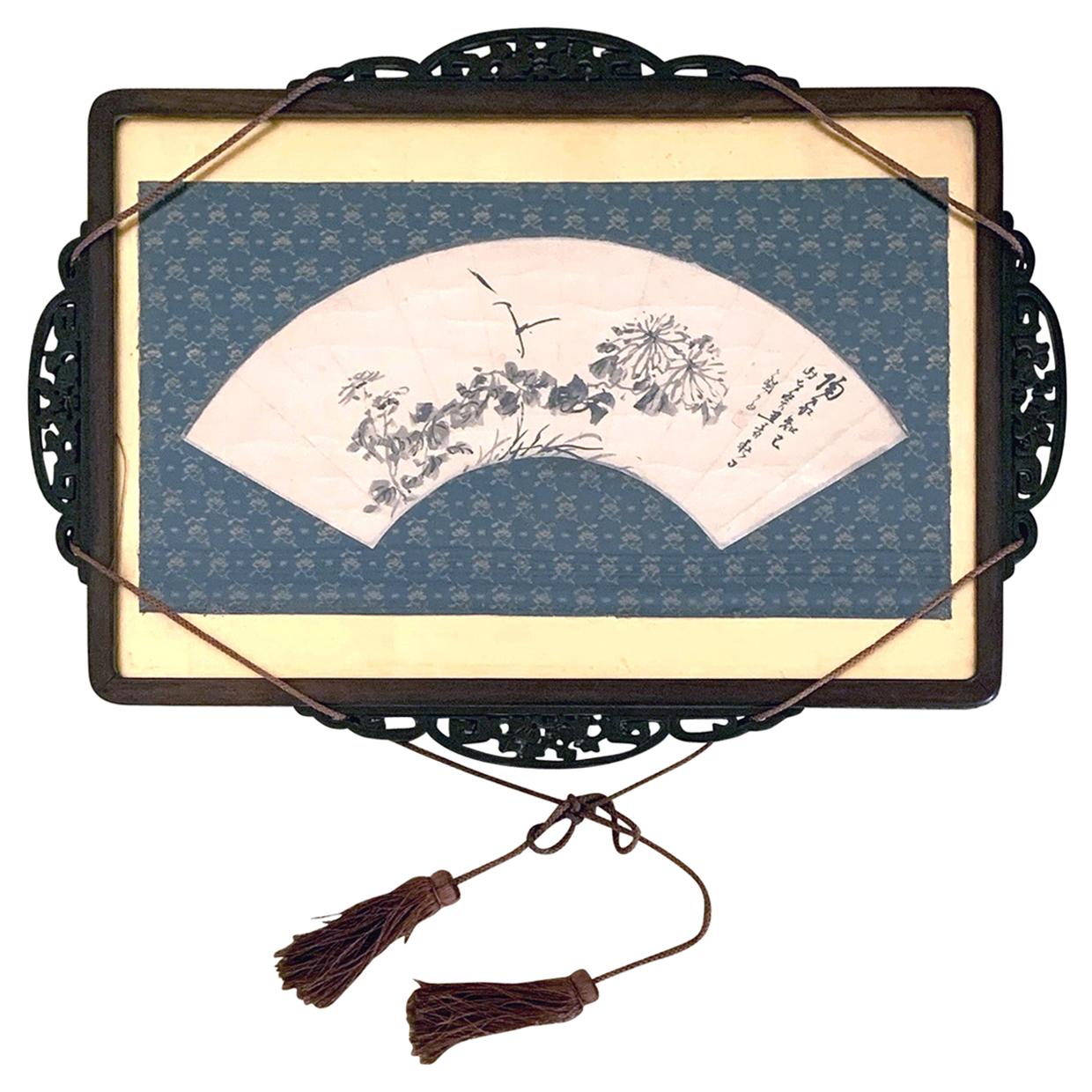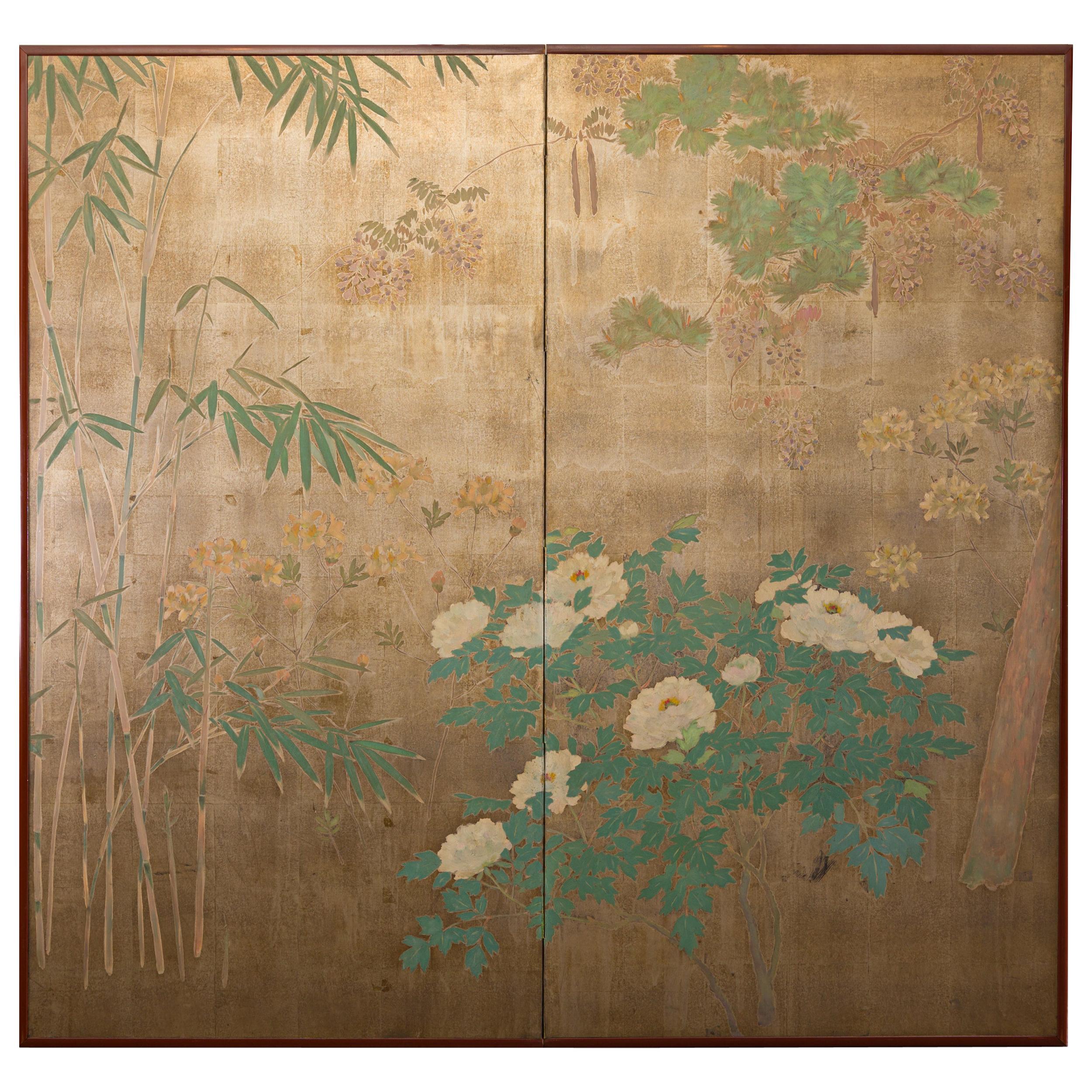Items Similar to Yamamoto Shunkyo (1871-1933) Japanese Framed Painting Pair, Carp and Bamboo
Want more images or videos?
Request additional images or videos from the seller
1 of 6
Yamamoto Shunkyo (1871-1933) Japanese Framed Painting Pair, Carp and Bamboo
About the Item
Two framed panels by Yamamoto Shunkyo depicting a carp (koi) leaping from a river.
Ink and gold leaf on paper.
Instinctively brushed in a freehand style, Shunkyo convincingly depicts a leaping carp and reeds with a tangible surface texture and volume. Painted entirely in the foreground the work is immediate and contemporary, the glittering gold surface the source of infinite space. It is a subject that Shunkyo painted often in scroll format, on both paper and silk. This is perhaps the first time the subject has been recorded on a gold-leaf ground. The different absorbent qualities of each surface distinctly alter the behaviour of the ink. Here Shunkyo’s succint brush-strokes and washes have formed astonishing variations in tonality, producing a work of art entirely in keeping with his desire to express nature’s spiritual realm through its physical dimension.
Yamamoto Shunkyo (1871-1933) studied briefly with Nomura Bunkyo before becoming a student of Mori Kansai in 1885. He emerged as a talented young artist is the 1890s. In 1899 he became a teacher at the Kyoto Municipal School of Arts and Crafts, a decade later he was appointed to the Kyoto Municipal Special School of Painting. After 1900 he emerged as one of the most successful nihonga artists in Kyoto. His private teaching atelier flourished, sharing popularity with Takeuchi Seiho’s atelier. When the Bunten opened in 1907, Shunkyo was appointed a jury member, reinforcing his prominence within the Kyoto painting circle. His early influences were photography and Western style painting (yoga). Shunkyo also valued the observation of nature through sketching (shasei). The traditional brush method played and important role in Shunkyo’s art. He investigated brush techniques associated with Chinese landscape paintings of the Song dynasty.
Dimensions:
Each image - H. 37” x W. 18” (94 cm x 45 cm).
- Dimensions:Height: 37 in (93.98 cm)Width: 18 in (45.72 cm)Depth: 0.75 in (1.91 cm)
- Sold As:Set of 2
- Style:Meiji (Of the Period)
- Materials and Techniques:
- Place of Origin:
- Period:
- Date of Manufacture:circa 1910
- Condition:Refinished. Professionally restored and remounted in Kyoto.
- Seller Location:Kyoto, JP
- Reference Number:1stDibs: LU247236416883
About the Seller
5.0
Recognized Seller
These prestigious sellers are industry leaders and represent the highest echelon for item quality and design.
Gold Seller
These expertly vetted sellers are highly rated and consistently exceed customer expectations.
Established in 2001
1stDibs seller since 2016
60 sales on 1stDibs
Typical response time: 6 hours
- ShippingRetrieving quote...Ships From: Kyoto, Japan
- Return PolicyA return for this item may be initiated within 10 days of delivery.
More From This SellerView All
- Japanese Painting, Framed Panel, Dahlias and Roosters, circa 1920Located in Kyoto, JPTanaka Tessen (b.1890) Dahlias and Roosters Taisho period, circa 1920 Framed painting. Mineral pigments and ink on silk. Dimensions (framed): H. 159 cm x W. 97 cm x D. 2.5 cm (62.5” x 38” x 1”) An ornate and complex composition in which the artist explores almost the entire painting surface. The coloration is bold and evocative and the tinted silk ground recreates the warm golden glow of sunset. Soft, luminous brushwork details the black feathers of the roosters, which seem to cloud and blur in counterpoint to the sharper points of the eyes and beaks. Their brilliant red combs balance the composition, echoing the rich burgundy hues of the dahlias; the flowers exquisite and lifelike. Dahlias were an exotic subject favored by painters of the Taisho era. The painting belongs to the school of Kyoto Nihonga, exemplifying the principles of decorative elegance and consumate brush technique with which it was intimately associated. Painters of the time relied on the Shijo school method, basing the forms of the composition from life sketches. Sometimes they were then integrated with elements derived from Chinese bird and flower...Category
Vintage 1920s Japanese Taisho Paintings and Screens
MaterialsSilk, Wood
- Japanese Framed Silk Painting, Turtledoves and Peaches, Taisho Era, circa 1920Located in Kyoto, JPNakamura Daizaburo Turtledoves in a Peach Tree Taisho period, circa 1920 Framed painting. Mineral pigments, ink and gofun on silk Signed: Daizaburo Dimensions (framed)...Category
Vintage 1910s Japanese Taisho Paintings and Screens
MaterialsWood, Silk
- Japanese Painting, Framed Panel, Willow and Sparrows, circa 1920 Taisho eraLocated in Kyoto, JPAnonymous Summer willow and sparrows Taisho period, circa 1920 Framed painting. Mineral pigments, mica, gold, ink and gofun on silk Dimensions (framed): H. 98 cm x W. 135 cm x D...Category
Vintage 1920s Japanese Taisho Paintings and Screens
MaterialsWood, Silk
- Early 20th Century Japanese Framed Painting, White Peacocks on Silk and GoldLocated in Kyoto, JPKasahara Seiken White peacocks, circa 1916 Framed painting. Ink, color and gofun on silk. A Taisho period Japanese nihonga painting depicting a pair of white peacocks re...Category
Early 20th Century Japanese Taisho Paintings and Screens
MaterialsGold Leaf
- Japanese Painting, Hanging Scroll, 19th Century Bamboo in MoonlightLocated in Kyoto, JPBamboo in moonlight Gamo Rakan (1784-1866) Hanging scroll, ink on silk. Dimensions: Scroll: 201 cm x 58 cm Image: 137 cm x 45 cm In this early 19th century work by Gamo Rakan a light ink wash applied to the silk background silhouettes the moon and suggests the atmosphere of early evening. Even though it is a literati subject, Rakan’s bamboo is quite realistic with a strong decorative style. The painting finds its inspiration from Chinese Ming dynasty painters who often used a single-tone, jet black stroke to emphasize the calligraphic nature of bamboo. In a different era, decorative would have been seen as somewhat unrefined. But increasingly in the Edo period, it was the hallmark of high style. The Japanese people, in particular the rising merchant class, had gradually become apathetic toward the traditional Sesshu and Kano schools of painting. Chinese professional and amateur painters living in the port of Nagasaki during the 18th century had a profound effect on Japanese painting and the freshness of their style and its decorative appeal contributed greatly to its popularity. Gamo Rakan’s teacher, Tani Buncho...Category
Antique Early 19th Century Japanese Edo Paintings and Screens
MaterialsSilk
- 19th Century Japanese Silk Painting by Kano Chikanobu, Peacock & BambooLocated in Kyoto, JPBirds & Flowers of the Seasons Pheasants & Plum in Snow Unframed painting. Ink, pigment and gofun on silk Kano Chikanobu 1819-1888 Signature...Category
Antique Mid-19th Century Asian Edo Paintings and Screens
MaterialsSilk
You May Also Like
- Fine Framed Japanese Brush Painting of BodhisattvaLocated in Greenwich, CTrefined Japanese brush painting of Bodhisattva sitting by stream, waterfall and pine tree, ink and color on silk, 19th century, conservation fr...Category
Antique 19th Century Japanese Meiji Paintings and Screens
MaterialsSilk
- Framed Japanese Ink Painting Hidaka TetsuoBy Hidaka TetsuoLocated in Atlanta, GAAn ink painting on the fan surface by Japanese Zen artist Hidaka Tetsuo (1791-1871), now framed in a traditional Japanese carved wood frame with silk fabric mat and decorative hangin...Category
Antique 1850s Japanese Japonisme Paintings and Screens
MaterialsWood, Paper
- Large Framed Japanese Buddhist Amida Temple Hall Painting, Mid-19th CenturyLocated in Austin, TXA large and incredible Japanese painting of a Buddhist temple hall with Amida Nyorai, late Edo or early Meiji period, mid-19th century, Japan. Mounted wit...Category
Antique Mid-19th Century Japanese Meiji Paintings and Screens
MaterialsWood, Paint, Brocade, Silk, Acrylic
- Japanese Two-Panel Screen Peony, Wisteria, Cherry and Bamboo on Soft SilverLocated in Hudson, NYJapanese two-panel screen: Peony, Wisteria, cherry and bamboo on soft silver, Meiji period (1868-1912) painting of a garden in spring. Painted in mineral pigments on oxidized silver ...Category
Antique Early 1900s Japanese Meiji Paintings and Screens
MaterialsSilver Leaf
- Large Antique Horizontal Japanese PaintingLocated in Lambertville, NJAn antique horizontal Japanese Meiji period qouache watercolor painting with black lacquered frame under glass. 65.5 inches long, 17inches high. Th...Category
Antique 1880s Japanese Meiji Paintings and Screens
MaterialsGlass, Hardwood, Paper
- Japanese Single Panel Painting Moon and Plum Design 'Winter Scene'Located in Hudson, NYMeiji period (1868-1912) ink painting of plum branches in bloom against a full moon with calligraphy. The calligraphy is a poem about winter. Signature reads: Matsuura Ryosai, Dated:...Category
Antique Late 19th Century Japanese Meiji Paintings and Screens
MaterialsPaper
Recently Viewed
View AllMore Ways To Browse
Pair Framed Gold
Pair Framed Panel
Pair Of Framed Panels
Japanese Arts And Crafts
Gold Gilt Frame Art
Gold Gilt Frame Paintings
Gold Leaf Art Pair
Gilt Frame Painting Pair
Pair Of Paintings Gold Frame
Pair Of Gilt Frame Art
Painted Bamboo Frame
Pair Of Asian Art Paintings
Japanese Brush
Japanese Brushes
Pair Of Asian Paintings
Traditional Japanese Painting
Gold Frame Pair Of Art
Asian Painting On Gold Leaf





